Royal Navy
-
- Tomorrow’s Defense: Unmanned Vehicles Enter the Naval Arena Marine Technology, Jan 2017 #18
A little more than a year ago, 40 global research and defense companies met to discuss how unmanned systems could be used by the world’s armies, air forces and navies in the defense systems of the future. This led to the British Royal Navy staging its first ‘robot wars’ last fall to give companies the chance to demonstrate their latest technology in a realistic workout. In the largest exercise of its kind ever staged, ‘Unmanned Warrior’, held off the coasts of Scotland and Wales, provided an international showcase for industry to demonstrate what autonomous systems can do for naval warfare, including the use of unmanned vessels (AUVs, ROVs, USVs) in surveys, antisubmarine warfare, ISTAR (information, surveillance, target acquisition and reconnaissance) and mine hunting.
Royal Navy Fleet Robotics Officer, Commander Peter Pipkin, stated that Unmanned Warrior, the brainchild of First Sea Lord Admiral Sir George Zambellas, was “a unique and innovative challenge to deliver the Royal Navy’s vision for autonomous systems.”Sir Philip Jones, Fleet Commander and Vice-Admiral at the time, added that as an instinctive innovator and exploiter of modern technology, the Royal Navy was enthusiastic about new ideas, new concepts and new technology: “In our view the unique selling point of Unmanned Warrior is its ability to provide a playground, if you like, in which we can simultaneously demonstrate unmanned systems and do so across a range of warfare disciplines. We see a clear opportunity to shape the future of not just the Royal Navy but a raft of our partners.”Challenging Test EnvironmentThe main planning conference for the exercise took place last October and Unmanned Warrior saw representatives from defense, industry and academia discuss how to deliver such a large unmanned systems event and decided that the demonstration of unmanned systems would be overlaid onto the twice-yearly multinational ‘Joint Warrior’ exercise to set a more challenging environment for the participants and allow the Royal Navy to see first-hand how some of the systems and sensors could integrate into current and future operations.Unmanned Warrior saw more than 50 vehicles, sensors and systems operating in a number of themed activities in the U.K. Ministry of Defense exercise areas based around Scotland and Wales, the organizers deliberately trying to keep the scope of activity as broad as possible with few, if any, constraints on what participants were allowed to demonstrate.“Unmanned Warrior was about seeking innovative ways to operate on the leading edge of technology; it wasn’t about removing humans from the decision chain or replacing every bit of our current capabilities with unmanned systems. If a system was unmanned and could operate in the maritime environment then we worked hard to find a way of incorporating it into the program,” said Commander Pipkin.Admiral Sir Philip Jones, First Sea Lord and Chief of Naval Staff, added, “Unmanned Warrior clearly demonstrated the Royal Navy’s ambition to lead and win through technological innovation. Unmanned maritime systems will change how we operate, but they’re just the start. Our pursuit of new technologies and ideas – from big data to 3D-printing – will ensure we remain one of the most capable and successful navies in the world.”Delivering Maritime CapabilityWhen the Unmanned Warrior program was completed in line with the U.K. government’s Strategic Defense and Security Review direction on innovation and defense exports, the Royal Navy invited industry, academia and other defense partners, including the U.S. Navy and NATO’s Center for Maritime Research and Experimentation, to safely experiment and demonstrate the potential offered by maritime autonomous systems within the Joint Warrior operational environment, exploring the feasibility of increasing the use of unmanned and autonomous systems in delivering maritime capability, featuring the latest unmanned system technologies for air, surface and sub-surface use.Joint Warrior provides a complex environment in which U.K., NATO and allied units can go through training together in tactics and skills for use in a combined joint task force. The exercise runs through a range of scenarios, including crisis and conflict situations, that could be realistically encountered in operations taking place over disputed territory, or against terrorist activity, piracy and more. Unmanned Warrior was explicitly designed to fit into this framework while also demonstrating British innovation and highlighting the strengths of British industry.Taking place in the fall of 2016, Unmanned Warrior saw 40 participants from industry, academia and defense, including the U.S. Navy and NATO’s Center for Maritime Research and Experimentation, operating unmanned and autonomous vehicles, sensors and software in the air, on the surface and underwater in an exercise predominantly funded by the participants that provided a showcase for the demonstration of products in a tactically relevant environment. Commander Pipkin commented, “The overall value [of Unmanned Warrior] is in transforming the market as a whole by creating increased demand for these technologies, not seeking specific business opportunities within the event.”Technology ThemesThe demonstrations in Unmanned Warrior were based around the following five themes that were selected by participants:- Antisubmarine Warfare (ASW)
- Information, Surveillance, Target Acquisition, and Reconnaissance (ISTAR)
- Command and Control
- Hydrographic and Geointelligence
- Mine Countermeasures (MCM)
“We deliberately adopted a different approach to capability demonstration in that the MOD invited participants to offer their thoughts on what future capability might look like and where technology could be exploited without any preconceptions,” stated Commander Pipkin. “This recognizes that we do not always have a crystal ball but are willing to look at the full breadth of possible technology exploitation paths.”The 40 industry partners and international allies showcasing the latest in remote technology presented more than 50 aerial, surface and underwater maritime autonomous systems (MAS) in a range of demonstrations on the themes of surveillance, intelligence-gathering and mine countermeasures. The collaborative approach of Unmanned Warrior is at the heart of the U.K.’s new Defense Innovation Initiative and the £800 million ($985 million) fund that supports the generation of ideas to benefit both the country’s defense and British business. U.K. Defense Secretary, Michael Fallon MP, commented, “The sheer scale of this exercise demonstrates how our armed forces are leading in developing futuristic technologies to keep us safe at sea or in the air. This is part of our new approach to harnessing innovation, backed by a rising defense budget, to ensure we keep ahead of our adversaries.”Commander Pipkin added, “The technologies demonstrated in Unmanned Warrior have the potential to fundamentally change the future of Royal Navy operations just as the advent of steam propulsion or submarines did. This is a chance to take a great leap forward in maritime systems – not to take people out of the loop, but to enhance everything they do, extending our reach and efficiency using intelligent robotics at sea.”Thales Group: Benefits of taking part in Unmanned WarriorThales Group played a key role in the U.K. Royal Navy’s Unmanned Warrior exercise held in the fall of 2016. Thales demonstrated its capability through the Watchkeeper Unmanned Aircraft System, the Halcyon Unmanned Surface Vehicle and its collaborative work in the field of unmanned command and control research. Watchkeeper, currently in service with the British Army, flew for the first time in a littoral naval environment operating alongside a Type 23 warship and a merchant vessel and was integrated into a series of exercises varying from persistent wide-area surveillance support up to 150 km offshore to landing forces and naval gunfire support. Data collected by Watchkeeper were streamed down remotely to the vessels and analyzed by operators to make better-informed command decisions in support of the trials.Also participating was Thales’s Halcyon Unmanned Surface Vehicle (USV) equipped with a Thales Towed Synthetic Aperture Sonar. The USV took part in a number of minehunting challenges aimed at demonstrating the significant benefits of autonomous technology when operating in hostile environments, including the reduction of risk to life. Missions using Halcyon were planned and coordinated using Thales mission management software, providing comprehensive command and control of the USV operation. Thales is a key sensor provider to the Royal Navy’s existing minehunting fleet through the operationally proven Sonar 2093 and Sonar 2193.Thales is also involved, with industry partners, in the U.K.’s Defense Science Technology Laboratory (DSTL) innovative research program MAPLE (Maritime Autonomous Platform Exploitation), which is developing the future architecture for Unmanned Systems Command and Control by enabling multiple unmanned platforms, such as unmanned air vehicles (UAVs), unmanned surface vehicles (USVs) and unmanned underwater vehicles (UUVs), and their payloads, to be commanded and controlled from a single control station. The company has been instrumental in the design of this multi-domain architecture and has brought experience of operating unmanned vehicles into this design activity.(As published in the January/ February 2017 edition of Marine Technology Reporter) -
- U.K. Ministry Of Defence Selects MFV Incinerators For Royal Navy Frigates Maritime Reporter, Nov 1986 #20
, marketed in the United Kingdom by Marine Ventures Ltd., as the most suitable commercially available incinerator for onboard installation on the Royal Navy's recently ordered Type 23 frigates. The Ministry of Defence selected the MFV incinerator after thoroughly testing and comparing the various
-
- Royal Navy Purchases Raytheon Bathy System Maritime Reporter, Nov 1985 #8
—Literature Available The British Royal Navy has purchased a deepwater bathy system from Raytheon Ocean Systems Company, East Providence, R.I., and installed it aboard the HMS Challenger, a new seabed operations vessel. The Challenger is one of the world's most technologically advanced hydrographic
-
- BRITAIN A Marine Industry Review Maritime Reporter, Mar 1985 #20
Pacific Guardian, the company is applying the same techniques to warships. The Swan Hunter yards are currently building two Type 22 frigates for the Royal Navy, and have recently completed sea trials with the aircraft carrier Ark Royal, which is shortly to be handed over to the Royal Navy. This ship
-
- U.K. Royal Navy Increases Overhaul Efficiency of HP Air Cylinders Maritime Reporter, Jul 2002 #24
The U.K. Royal Navy, Marine Fluid Power Fire Fighting & Mechanical Handling Integrated Project Team (MFFMIPT) Submarine Division, implemented a tailor made version of the recently launched portable Valve Seat Lathe, type VSL, from Swedish manufacturers Chris-Marine. As a result, the MFFMIPT claims to
-
- VT Reaches Milestone With New RN Survey Ships Maritime Reporter, Jun 2001 #20
Construction of two new 295 ft. (90 m) hydrographic and oceanographic survey ships for the Royal Navy, under the prime contractorship of Vosper Thornycroft (VT), has taken another step forward with the initial blocks being moved to the berth in the covered Building Dock at Appledore Shipbuilders in
-
- VT To Unveil Shipyard Technology Investment Maritime Reporter, Apr 2003 #51
facility, a nearly $60 million investment located within Portsmouth Naval Base. From the start. the facility will be used to build blocks for all the Royal Navy's new 7.500-ton type 45 destroyers, as VT will build the forward section, funnel and mast section for these ships. In addition, the company is
-
- Team UMC Helps Navy Ship With Innovative VSP Switch Maritime Reporter, Oct 2003 #33
the British Ministry of Defense (MoD) to successfully complete the afloat replacement of a 7.5-ton Voith Schneider Propulsor (VSP) unit, while the Royal Navy ship was operating over 3,000 miles from its UK base port. The VSP waterborne exchange is, reported by the MoD, to be a premiere culmination of
-
- ALSTOM Wins $102M Navy Deal Maritime Reporter, Nov 2004 #73
ALSTOM has won a second order of around $102 million to supply an integrated electric power and propulsion system for the Royal Navy's Anti-Air Warfare Type 45 Destroyers. Following on from the first contract in April 2001 for batch one, this order is for batch two vessels and was awarded by BAE Syste
-
- Launch Carrier 'HMS Ark Royal' To Be Completed By Mid-'80s Maritime Reporter, Sep 1981 #56
HMS Ark Royal, the Royal Navy's latest antisubmarine aircraft carrier (above) is pictured after her launch from the Swan Hunter yard on the River Tyne in northeast England recently. The last Invincible-class t h r o u g h - d e ck cruiser to be built, HMS Ark Royal has an expected completion date of
-
- Type 45 Destroyer Build Plans Modified Maritime Reporter, Aug 2001 #53
The Secretary of State for Defense announcement on the royal Navy's Type 45 destroyer was hailed as a boon for South Coast Shipbuilding, as the revised strategy means that Vosper Thornycroft (VT) will play a significant role in the Type 45 program, building sections for all ship in the class. "The
-
- Trimaran Demonstrator Progressing At VT Maritime Reporter, May 2000 #32
to DERA in August before starting the initial phase of a trials program that will determine whether trimaran hulls will be considered for the Royal Navy's Future Surface Combatant. BT has built the ship using mega- blocks weighing up to 200 tons each. Five mega blocks have been fabricated and
-
 )
March 2024 - Marine Technology Reporter page: 11
)
March 2024 - Marine Technology Reporter page: 11, including sidescan and synthetic aperture sonars, as well as laser scanners. Ukraine is al- ready in possession of six Remus 100 AUVs provided by the Royal Navy for MCM purposes, but a multinational mine clearance operation would em- ploy numerous AUVs to measure mine- ? eld scale and density. Once mapped
-
 )
March 2024 - Marine Technology Reporter page: 9
)
March 2024 - Marine Technology Reporter page: 9from marinas along the western coast. The exact number of lizing laser detection systems can detect mines just below the mines, as well as their locations, remains largely a mystery, surface, even those hiding in murky water. The Airborne Laser although reports suggest that over three hundred have been
-
 )
March 2024 - Marine Technology Reporter page: 6
)
March 2024 - Marine Technology Reporter page: 6MTR Editorial Advisors Gallaudet Hardy The Honorable Tim Gallaudet, Kevin Hardy is President PhD, Rear Admiral, U.S. of Global Ocean Design, Navy (ret) is the CEO of creating components and Ocean STL Consulting and subsystems for unmanned host of The American Blue vehicles, following a career
-
 )
April 2024 - Maritime Reporter and Engineering News page: 29
)
April 2024 - Maritime Reporter and Engineering News page: 29RADM PHILIP SOBECK, MILITARY SEALIFT COMMAND U.S. Navy photo by Bill Mesta/released U.S. Navy photo by Ryan Carter Rear Adm. Philip Sobeck, Commander, United States Navy’s Military Sealift Command, visits USNS Patuxent (T-AO 201) for a tour of the ship at Naval Station Norfolk, Va., November 20, 2023.
-
 )
April 2024 - Maritime Reporter and Engineering News page: 28
)
April 2024 - Maritime Reporter and Engineering News page: 28FEATURE INTERVIEW track missiles and warheads for the Mis- sile Defense Agency, and it travels with its support ship, the MV Hercules. For our Service Support ships, we have the two hospital ships, USNS Mer- cy and Comfort; two rescue and salvage ships; two submarine tenders; and the Sixth Fleet ?
-
 )
April 2024 - Maritime Reporter and Engineering News page: 27
)
April 2024 - Maritime Reporter and Engineering News page: 27RADM PHILIP SOBECK, MILITARY SEALIFT COMMAND With COVID, we had to make some hard choices for our Do your CIVMARs have upward mobility? mariners because we couldn’t rotate. Many of our mariners The Navy has Sailors who become “Mustangs,” and work found other employment, and were able to use their skills
-
 )
April 2024 - Maritime Reporter and Engineering News page: 26
)
April 2024 - Maritime Reporter and Engineering News page: 26FEATURE INTERVIEW “Over the next decade, 12 new classes of ships will come online and MSC will see up to 20 new ships deliver to the ? eet in the next ? ve years. This includes new oilers, towing, salvage and rescue tugs, and expeditionary fast transports and emergency medical ships. A large
-
 )
April 2024 - Maritime Reporter and Engineering News page: 25
)
April 2024 - Maritime Reporter and Engineering News page: 25RADM PHILIP SOBECK, MILITARY SEALIFT COMMAND Photo by Brian Suriani USN Military Sealift Command From a global supply chain perspective, What makes MSC so vital to the we’ve learned a lot about dealing with Navy’s ? eet and our military disruptions. COVID delivered a big forces around the world? wake-up
-
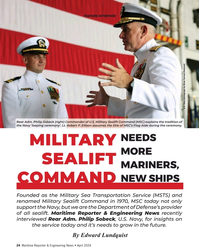 )
April 2024 - Maritime Reporter and Engineering News page: 24
)
April 2024 - Maritime Reporter and Engineering News page: 24FEATURE INTERVIEW U.S. Navy photograph by Brian Suriani/Released Rear Adm. Philip Sobeck (right) Commander of U.S. Military Sealift Command (MSC) explains the tradition of the Navy ‘looping ceremony’. Lt. Robert P. Ellison assumes the title of MSC’s Flag Aide during the ceremony. NEEDS MILITARY MORE
-
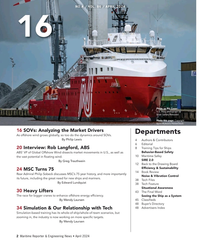 )
April 2024 - Maritime Reporter and Engineering News page: 2
)
April 2024 - Maritime Reporter and Engineering News page: 2NO.4 / VOL. 86 / APRIL 2024 16 Photo on the Cover: U.S. Navy photograph by Brian Suriani/Released Photo this page: Copyright Björn Wylezich/AdobeStock 16 SOVs: Analyzing the Market Drivers Departments As offshore wind grows globally, so too do the dynamics around SOVs. By Philip Lewis 4 Authors & Contribut
-
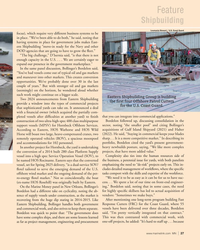 )
April 2024 - Marine News page: 27
)
April 2024 - Marine News page: 27Feature Shipbuilding Loumania Stewart / U.S. Coast Guard focus), which require very different business systems to be in place. “We’ve been able to do both,” he said, noting that having systems in place for government jobs makes East- ern Shipbuilding “move-in ready for the Navy and other DOD agencies
-
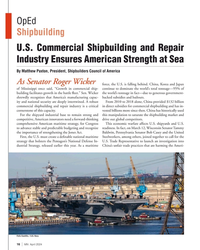 )
April 2024 - Marine News page: 16
)
April 2024 - Marine News page: 16OpEd Shipbuilding U.S. Commercial Shipbuilding and Repair Industry Ensures American Strength at Sea By Matthew Paxton, President, Shipbuilders Council of America As Senator Roger Wicker force, the U.S. is falling behind. China, Korea and Japan of Mississippi once said, “Growth in commercial ship-
-
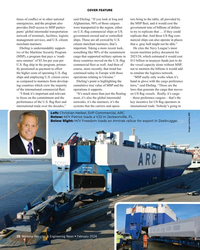 )
February 2024 - Maritime Reporter and Engineering News page: 28
)
February 2024 - Maritime Reporter and Engineering News page: 28COVER FEATURE times of con? ict or in other national said Ebeling. “If you look at Iraq and tors bring to the table, all provided by emergencies, and the program also Afghanistan, 98% of those cargoes the MSP ? eet, and it would cost the provides DoD access to MSP partici- were transported to the
-
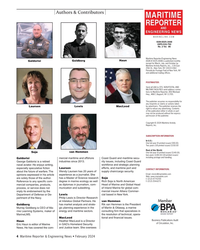 )
February 2024 - Maritime Reporter and Engineering News page: 4
)
February 2024 - Maritime Reporter and Engineering News page: 4Authors & Contributors MARITIME REPORTER AND ENGINEERING NEWS M A R I N E L I N K . C O M ISSN-0025-3448 USPS-016-750 No. 2 Vol. 86 Maritime Reporter/Engineering News Goldberg Haun (ISSN # 0025-3448) is published monthly Galdorisi except for March, July, and October by Maritime Activity Reports, Inc.
-
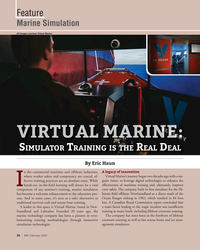 )
February 2024 - Marine News page: 34
)
February 2024 - Marine News page: 34as a safer alternative to Ocean Ranger sinking in 1982, which resulted in 84 lives traditional survival craft and rescue boat training. lost. A Canadian Royal Commission report concluded that A leader in this space is Virtual Marine, based in New- a main factor leading to the tragic incident was insuf?
-
 )
January 2024 - Marine Technology Reporter page: 60
)
January 2024 - Marine Technology Reporter page: 60brings together thought leaders from industry, academia and Dockside Demonstrations government to discuss meeting future ocean technology needs On the Royal Victoria Dock, the Dockside Demos feature in line with market developments and new ocean enterprise gives visitors the opportunity to experience
-
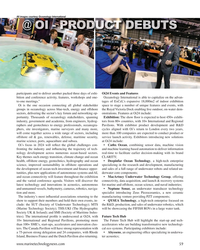 )
January 2024 - Marine Technology Reporter page: 59
)
January 2024 - Marine Technology Reporter page: 59all global stakeholder space to stage a number of unique features and events, with groups in oceanology across blue-tech, energy and offshore the Royal Victoria Dock enabling live outdoor, on-water dem- sectors, delivering the sector’s key forum and networking op- onstrations. Features at Oi24 include: port
-
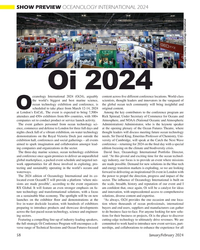 )
January 2024 - Marine Technology Reporter page: 58
)
January 2024 - Marine Technology Reporter page: 58, where nights chock full of a vibrant exhibition, on-water technology thought leaders will discuss meeting future ocean technology demonstrations on the Royal Victoria Dock just outside the needs. Sir David King, Emeritus Professor of Chemistry, Uni- exhibition hall, conferences and social gatherings – all
-
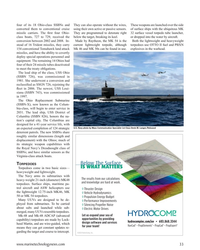 )
January 2024 - Marine Technology Reporter page: 33
)
January 2024 - Marine Technology Reporter page: 33patrols. The new SSBNs share roughly similar dimensions (length and displacement) with the Ohios; much of its strategic weapon capabilities with the Royal Navy’s Dreadnought class of SSBNs; and have similar sensors as the Virginia-class attack boats. Below The Surface TORPEDOES IS WHAT MATTERS Torpedoes
-
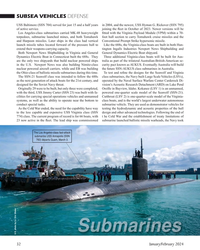 )
January 2024 - Marine Technology Reporter page: 32
)
January 2024 - Marine Technology Reporter page: 32SUBSEA VEHICLES DEFENSE USS Baltimore (SSN 704) served for just 15 and a half years in 2004, and the newest, USS Hyman G. Rickover (SSN 795) of active service. joining the ? eet in October of 2023. Newer versions will be Los Angeles-class submarines carried MK-48 heavyweight ? tted with the Virginia
-
 )
January 2024 - Marine Technology Reporter page: 31
)
January 2024 - Marine Technology Reporter page: 31at depths up to 1,000 feet. serve as a moored training ship (MTS ton. Some of the 688s were pulled from Hammerhead consists of a mooring 701) and the Nuclear Power School service at their mid-life point rather than module that plants itself on the bot- in Charleson, S.C. Likewise USS San incur the
-
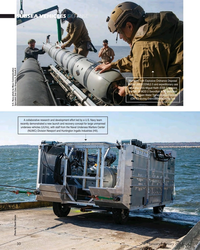 )
January 2024 - Marine Technology Reporter page: 30
)
January 2024 - Marine Technology Reporter page: 30SUBSEA VEHICLES DEFENSE Members from Explosive Ordnance Disposal Mobile Unit (EODMU) 5 and expeditionary sea base ship USS Miguel Keith (ESB 5) prepare the MK 18 MOD 2 Sword? sh to be deployed from the Open Water Transportation System (OWTS) during Exercise Noble Vanguard. U.S. Navy photo by Mass
-
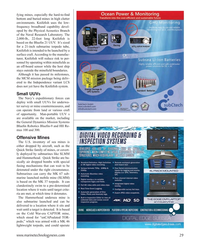 )
January 2024 - Marine Technology Reporter page: 29
)
January 2024 - Marine Technology Reporter page: 29fying mines, especially the hard-to-? nd bottom and buried mines in high clutter environments. Knife? sh uses the low- frequency broadband capability devel- oped by the Physical Acoustics Branch of the Naval Research Laboratory. The 2,000-lb., 22-foot long Knife? sh is based on the Blue? n 21 UUV.
-
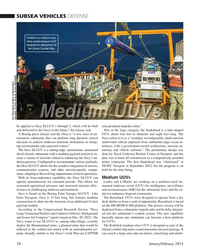 )
January 2024 - Marine Technology Reporter page: 28
)
January 2024 - Marine Technology Reporter page: 28SUBSEA VEHICLES DEFENSE Knife? sh is a medium-class mine countermeasure UUV designed for deployment off the Littoral Combat Ship. U.S. Navy photo by Mass Communication Specialist 1st Class Brian M. Brooks/RELEASED be applied to Orca XLUUV 1 through 5, which will be built (encapsulated torpedo) mine.
